A treasure trove of knowledge turns 100
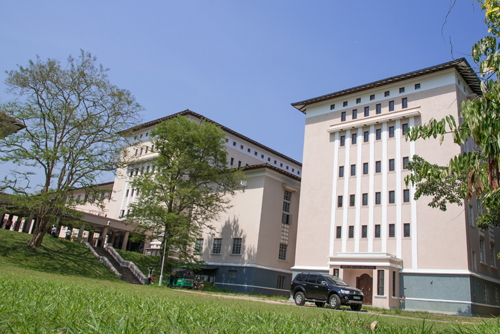
In the heart of the campus: The Pera library. Pic courtesy IT division of the Peradeniya library
Pass that fig tree spreading its branches like shadowy tentacles near the Faculty of Arts, and you are in the heart of the Peradeniya University, where stately pink buildings conspire with the dreamy Hantane range and luxuriant flora to create those timeless landscapes of youth.
We are walking across the quadrangles of Peradeniya to a rendezvous with a grand old dame celebrating her centenary this year: the ‘Pera Library’ that has known scholars flocking to her maternal bosom ever since university began in Ceylon.
For this library claims its genesis in a little room in the manorial College House down Thurstan Road, Colombo when in 1921, the Ceylon University College was founded. Sir Ponnambalam Arunachalam donated his late son Padmanabha’s library- some 3000 volumes- to be the nucleus.
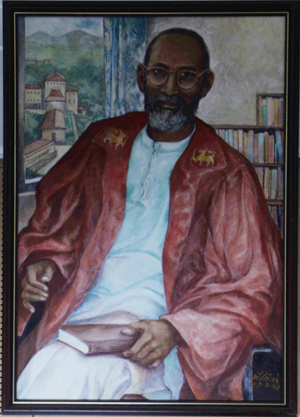
H. A. I. Goonetilleke: Legend behind the library, portrait by Stanely Kirinde
After College House the library went to Villa Venezia, a pink baroque mansion- the home of Sir Marcus Fernando. Here, though lacking the fabulous collection it would later amass, readers were in a fantastic world with classical frescoes copied from Venetian originals.
In 1952 the university was shifted to Peradeniya.
The current building that houses the library was completed in 1960. It is part of the ornate oyster pink Kandyan look which makes the campus classic against the lawns and gardens. Seven-storeyed, it has a new wing unveiled in August last year with five storeys. It is today the oldest academic library in the country and one of the biggest.
Enter the foyer, and you are greeted by H. A. I. Goonetilleke. The former librarian’s portrait hangs in state upstairs, but his lingering spirit hovers all over the collections put together with a bibliophile’s tender passion.
Typically he left most of what was his to his library when passing away in 2003. In the foyer is his private collection of sculptures- Natarajs and ancient idols in bronze kolam masks from down south sprinkled with some animal totems.
Ian Goonetilleke – only the second Sri Lankan to be Peradeniya’s guardian of books actually bequeathed on it a treasure much more priceless. His collection of George Keyt paintings today crowd the ‘dark room’ in the basement, awaiting the new gallery where they could be displayed in all their glory. An old handbook from 1972 is impregnated with Ian’s love for his library, organized with minutiae by this scholar who was one of the greatest authorities on the literature to do with old Ceylon.
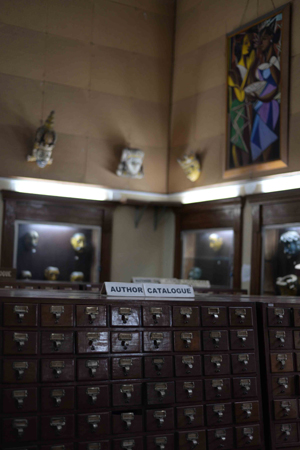
Unique collections: Sarachchandra’s masks on the wall and Keyt’s painting
The ground floor houses offices and includes the Ceylon Room, with a treasure of Sri Lankan books, govt. publications, statistical abstracts, annual reports, gazettes, theses, and special collections including the D. R. Wijewardene collection, the Leslie de Saram collection and the Donald Ferguson collection.
The grand stairway leads us up and on the first landing we draw up to admire the likeness of Rabindranath Tagore, languishing on a sofa with carpet slippers. It was gifted to the people of Lanka by the Calcutta Art Society. Displayed is a note by Dr. C. W. W. Kannangara about the ties historical between Tagore, Bengal and Ceylon.
The first floor is grand, high ceilinged, with a staggering collection of large exorcism masks on the high walls. This was the collection acquired by Dr. Ediriweera Sarachchandra while authoring his landmark volume The Folk Drama of Ceylon, bequeathed later to the library. These include the ornate daha ata sanni (healing rituals) masks, leering at students poring over the library catalogues.
Here only the whirring of fans and faint wheeling of trolleys disturb the students absorbed in tomes. A university library, we are reminded, is in ways a hermetically sealed place like the university itself- but nonetheless a place of memories- of discovering in silence fresh volumes of knowledge leading to new peaks, of long evenings between lectures and boisterous kuppi and clandestine romances.
Also in this floor is a reading room looking rather baronial with the ceiling panelled in wood, carved and polished, and rather ornate scrollwork, a tad reminiscent of an English stately home.
The library has many a special collection. The oldest and most venerable come from colonial scholars and bibliomanes. Apart from the A. Padmanabha collection there is Canon Lucien Jansz’s ‘five lorry-loads’ of books, and the collections of Charles Batuvantudave, T. W. Rhys Davids, Rev. Rambukwelle Siddhartha, A. C. Sulaiman, Andreas Nell, E. J. Thomas George Grierson, H.R. Hamley and Albert M. Fehring. These have been merged with the general collections, but later collections form their own niches.
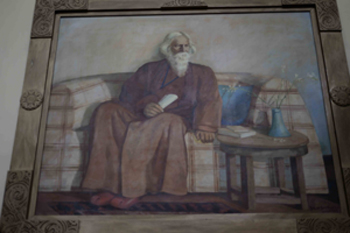
Gift from India: A painting of Tagore
These include those of W. Arthur de Silva, Richard Abeysekera, M. D. Ratnasuriya, John R. Blaze, R. Sri Pathmanathan, C. W. Nicholas, George H. Wikramanayake, Wiswa Warnapala, Savitri and R.K.W. Goonesekere, and the rambling Justice Weeramantry collections.
The D. P.E. Hettiarachchi collection was bought from a voracious collector while Bishop Lakdasa de Mel donated his father Henry de Mel’s collection together with the ornately carved Dutch almirahs which housed them.
Rodney Fernando, assistant librarian, leads us to the bowels of the library, the sprawling silent dark basement. Here thickly packed to the ceilings under faintly humming fluorescent light, are still wrapped volumes fresh from the printers. A copyright library since 1951, Peradeniya lays claim to a copy of every book published in the country, after the National Archives and the National Library of Sri Lanka. The rule is not always adhered to, however, by publishers/authors.
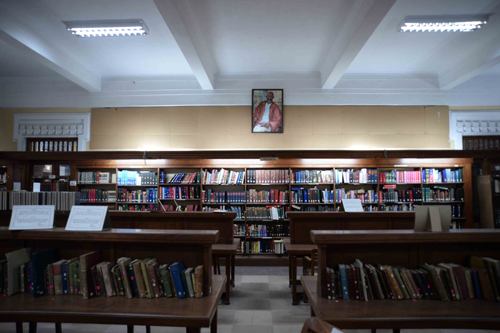
Pages from the past: A section of the reading room . Pix by Eshan Fernando
The library and its branches (seven of them) house between them 800,000 resource items (books, journals, newspapers, audio, video and computer disks), and the main library alone caters to some 9500 readers.
Mr. R. Maheswaran, the Librarian, is also the keeper of a selection of rare manuscripts not allowed to be viewed, which include the original manuscript of Leonard Woolf’s The Village in the Jungle and the private papers of E.W. Perera.
While the library caters mainly to the university community, Mr. Maheswaran reminds that alumni, media personnel of the Central Province and anyone engaged in research can, with special permission, avail themselves of the delights of this bibliophile’s haven.


